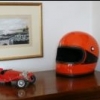David McKinney, on Dec 1 2010, 06:56, said:
Having read earlier posts, you will know that neither is a four-wheel drift, imperfect or otherwise
The second is close, as the four wheels are almost in parallel
And in both cases the Maestro maybe be in the throes of setting up a four-wheel drift - had the shutter been clicked a split-second later the four wheels may indeed have been in parallel
i didn't know that having the wheels parallel was a prerequisite of a four wheel drift. As i understand it, the technique was first developed in the late '30s when the German Grand Prix cars were first designed with inherent understeer, albeit with sufficient power to overcome it of course. to quote Pomeroy: "..in 1938/39 the arrival of understeering cars made it possible to get into the four-wheel drift which became general practice in the 'fifties. In this case, the driver slowed the car on the straight, gave a little kick to the tail by twitching the steering wheel so that the car got across the road, and then by laying on enough throttle to degrade the cornering power of the rear tyres without provoking wheelspin, he could take the whole car round, say a right-hand curve, with the nose facing very much into the corner but with no wheels actually skidding." (Design and Behaviour of the Racing Car, page 210).
This technique required a car which understeered at the limit of cornering power with no other forces acting on it. Most grand Prix cars from the late '30s to the mid-'50s were designed this way. THe 1955 version of the Mercedes W196 was designed to oversteer at the limit and Fangio and Moss developed a new technique where they applied power at the critical point to increase the cornering power of the rear tyres to the level of the fronts. This differs from the four-wheel drift as described by Pomeroy, because power was used to increase cornering power of the rear tyres, not to reduce it. The 250F always had final oversteer characteristics but it was only in 1957 that it had sufficient power to use the technique.All this, including the forces acting on the wheels that made it possible, is described in Denis Jenkinson's "The Racing Driver", from page 159.
That's my understanding of the techniques, but I may be wrong.

































